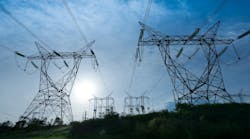In 1998, a group of power company representatives convened to address the growing need to push more power through existing transmission circuits. They met at EPRI’s high-voltage lab in Lenox, Massachusetts, U.S., and formed a task force to consider what new research and development (R&D) EPRI should undertake to help resolve the issue.
After exploring several proposed concepts and testing various prototypes over a period of several years, EPRI developed an instrument dubbed the Video Sagometer, which has since been commercialized and widely deployed.
EPRI’s Dynamic Thermal Circuit Rating (DTCR) software was modified to work with input from sag-measuring devices as well as other devices. DTCR was designed to calculate ratings in real time; however, often, it was found DTCR rating calculations could be used to perform rating studies, such as those recommended by CIGRÉ in technical bulletin 299.
Field-Testing Available Instruments
In addition to developing instruments for real-time transmission line ratings, EPRI-member power companies have sponsored projects with EPRI to field-test several types of commercially available instrument systems. Available instruments come in a wide range of designs that employ various concepts and techniques, but they generally fall into one of four classes: weather, conductor temperature, sag or tension measurements. There are pros and cons for each of these classes of instruments.
Instruments that make direct weather measurements are generally cheaper, their components are very reliable and the data needs little interpretation. However, such instruments measure the ambient conditions only at the site of installation. The other three classes of instruments all measure conductor temperature, either directly or indirectly. Conductor temperature measurements are used (along with air temperature and solar measurements) to determine an effective wind velocity to be used by rating calculations.
Direct conductor temperature measurements are made with a thermocouple pressed against the conductor. However, such a measurement only provides data for the point at which it is mounted and may not truly represent the average conductor temperature along the line. But the latter issue can be mitigated by installing multiple units.
Conductor sag or tension measurements can be used to determine the average conductor temperature along an entire line, which is a clever method of determining the effective wind velocity for rating calculations. However, this requires the determination of the state-change equation that functionally relates conductor temperature to conductor sag or tension. In addition, for any kind of conductor temperature measurement to be useful for rating calculations, the line load must not be very low (below about 0.5 A/kcmil). It is surprising how little time most lines meet this criterion.
A Do-It-All Instrument
Recently, a group of power companies identified the need for an instrument that can do it all. They sponsored the development of a new instrument that could measure conductor temperature, sag, line load and conductor vibration; could be widely deployed with networked communications; and would be inexpensive. With the help of Southwest Research Institute, a member-sponsored initiative was undertaken at EPRI and a system was developed that consists of multiple sensor units.
A single sensor measures conductor temperature with a thermocouple that fits snugly into the grooves of the conductor’s strands, measures conductor sag and vibration by means of an onboard 3-D accelerometer, and measures conductor load with a pickup coil that also powers the sensor. The instrument has been field-tested extensively, several versions of improving prototypes have been developed and commercialization is underway with Southwire.
Another important issue the industry is starting to consider seriously is the need for forecasted ratings. Knowing what the rating is now, or in real time, is great, particularly for emergency situations. However, knowing what the rating will be tomorrow or next week may be even more valuable. EPRI has several projects underway to investigate potential methodologies for performing forecasted ratings and will produce a guidebook on the subject next year.
The task force that first met in 1998 that oversees EPRI R&D in these areas still exists and is now chaired by Tyler
Ashburn of the Bonneville Power Administration. It meets twice annually to review ongoing and planned EPRI work, and, in addition to the ratings work discussed here, it oversees EPRI R&D on topics such as advanced conductor development, high-temperature operation, corona performance at elevated temperatures, advanced thermal models and the Increased Power Flow Guidebook (Platinum Book).
Bernie Clairmont is a senior project manager and scientist at EPRI. His research topics there include circuit ratings, high-voltage direct-current transmission, electromagnetic fields and corona effects.


